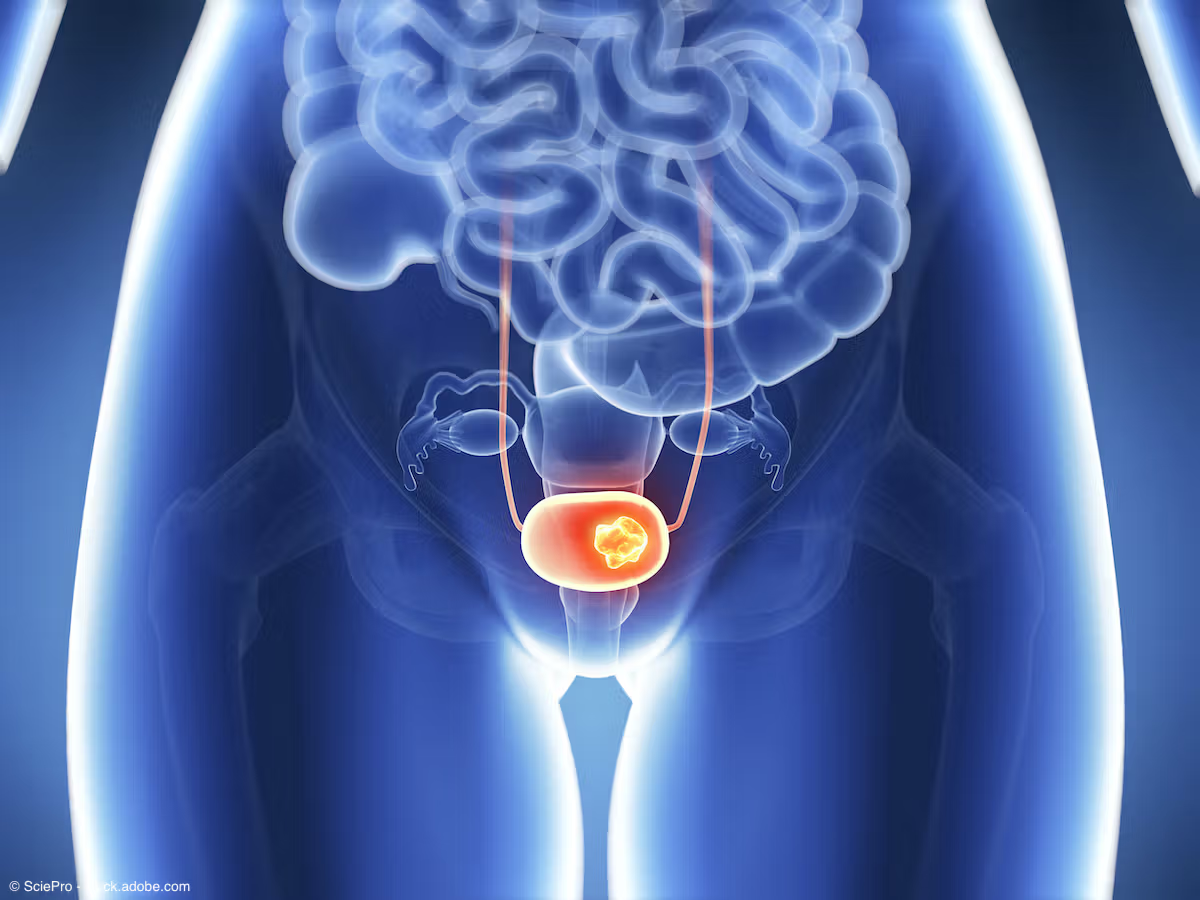News
Article
Disitamab vedotin plus toripalimab shows safety, efficacy in MIBC
Author(s):
Key Takeaways
- Disitamab vedotin plus toripalimab demonstrated a 63.6% pathologic complete response rate in HER2-expressing MIBC patients.
- The 12-month event-free survival rate was 92.5%, indicating promising efficacy for the combination treatment.
"The results [indicate] that neoadjuvant DV combined with toripalimab had promising efficacy and acceptable safety in patients with HER2-expressing MIBC,” said Xinan Sheng, MD.
Combination treatment with disitamab vedotin (DV) plus the anti-PD-1 inhibitor toripalimab appeared to confer benefits for patients with muscle-invasive bladder cancer (MIBC) with HER2 expression, according to recent results from the phase 2 RC48-C017 trial (NCT05297552).1
In the 33 patients who underwent radical cystectomy, pCR was seen in 21 (63.6%) patients (95% CI, 45.1-79.6).

“Several clinical trials that combine immunotherapy with ADC drugs in the neoadjuvant setting are ongoing. However, these trials have not [yet] published their findings,” said study author Xinan Sheng, MD, of the Key Laboratory of Carcinogenesis and Translational Research (Ministry of Education/Beijing), Department of Genitourinary Oncology, Peking University Cancer Hospital & Institute, China. Sheng presented the data at the 2025 American Society of Clinical Oncology Genitourinary (ASCO GU) Cancers Symposium in San Francisco, California.
In a previously reported phase 1b/2 clinical trial (RC48-C014), treatment with DV plus toripalimab was associated with confirmed objective response rate of 76.3% in patients with HER2 expression.2 The single-arm phase 2 RC48-C017 trial sought to evaluate the safety and efficacy of neoadjuvant DV plus perioperative toripalimab in patients with MIBC with HER2 expression.
Patients were eligible for the study if they had histologically confirmed urothelial carcinoma, had MIBC at stage cT2-T4a, N0-1, and M0, were eligible for radical cystectomy plus pelvic lymph node dissection, and had HER2 expression. Patients received DV 2 mg/kg plus toripalimab 3 mg/kg once every 2 weeks followed by radical cystectomy and adjuvant toripalimab 3 mg/kg once every 2 weeks for 20 cycles. The study’s primary end point was pathologic complete response (pCR) rate, which the investigators defined as ypT0N0. Secondary end points included pathological response rate (defined as ypT1N0M0 or lower), event-free survival (EFS), overall survival (OS), and adverse events (AEs). The investigators noted that “promising efficacy” and “acceptable safety” were observed in the preliminary results of the trial.3 At ASCO GU, Sheng presented updated results that included pathological response, EFS, safety, as well as other outcomes, with a longer follow-up period.
A total of 63 patients were screened, and 47 patients were enrolled and received neoadjuvant treatment. Thirty-three patients underwent radical cystectomy, and 14 did not undergo cystectomy. Sixteen patients received adjuvant treatment, and 17 did not receive adjuvant treatments. Median age was 64.0 years (range, 30-82 years). Most of the patients (34, 72.3%) were male. ECOG Performance Status was 0 in 25 (53.2%) patients and 1 in 22 (46.8%) patients. HER2 expression was IHC 1+ in 5 (10.6%) patients, 2+ in 27 (57.4%) patients, and 3+ in 15 (31.9%) patients. PD-L1 expression was negative in 25 (53.2%) patients, positive in 13 (27.7%) patients, and not available in 9 (19.1%) patients.
The median time from the end of neoadjuvant treatment to radical cystectomy was 5.0 weeks (range, 2.6-13.1 weeks). In the 33 patients who underwent radical cystectomy, pCR was seen in 21 (63.6%) patients (95% CI, 45.1-79.6), and pathological response was seen in 25 (75.8%) patients (95% CI, 57.7-88.9).
Looking at baseline cTN stage, the pCR rate in patients with T2N0 (n = 14), T3N0 (n = 11), T4N0 (n = 3), or TanyN1 (n = 5) disease was 85.7%, 36.4%, 66.7%, and 60.0%, respectively. The pCR rate in patients with pure urothelial carcinoma (n = 24) was 66.7% compared with 55.6% in patients with urothelial carcinoma with other differentiation or variants (n = 9).
“The pCR rate for the HER2 IHC 3+ subgroup was numerically higher than those for IHC 1+ and IHC 2+ subgroups regardless of PD-L1 status,” the authors wrote in their presentation.
Regarding EFS, the median follow-up was 14.1 months. Median EFS was not reached. The 12-month EFS rate was 92.5% (95% CI, 72.8-98.1), and the 18-month EFS rate was 85.9% (95% CI, 60.5-95.5). In the intent-to-treat (ITT) population, median EFS was not reached at a median follow-up of 15.6 months. The 12-month EFS rate was 90.5% (95% CI, 76.6-96.4), and the 18-month EFS rate was 82.7% (95% CI, 64.4-92.1).
Median OS in the ITT population was not reached at a median follow-up of 17.9 months. The 12-month OS rate was 95.5% (95% CI, 83.3-98.9).
For patients undergoing radical cystectomy, Clavien Dindo I, II, IIIa, and IIIb postoperative complications were observed in 8 (24.2%), 5 (15.2%), 1 (3.0%), and 1 (3.0%) patients respectively. Postoperative pain and stoma site infection occurred in 4 (12.1%) and 5 (15.2%) patients, respectively, and clotting disorder, pyrexia, pneumonia, intestinal obstruction, urinary tract infection, hydronephrosis, and septic shock all occurred in 1 patient each (3.0%).
In the ITT population, 47 patients (100%) experienced treatment-emergent AEs (TEAEs), and grade 3 or higher TEAEs occurred in 13 (27.7%) patients. Serious TEAEs occurred in 11 (23.4%) patients. Treatment-related AEs (TRAEs) occurred in 46 (97.9%) patients, and grade 3 or higher TRAEs occurred in 10 (21.3%) patients. Serious TRAEs occurred in 6 (12.8%) patients. The most common TEAEs included alopecia, increased aspartate aminotransferase, and increased alanine aminotransferase.
“Neoadjuvant DV combined with toripalimab did not delay radical surgery. The safety profile was manageable, with no new safety signals. The results [indicate] that neoadjuvant DV combined with toripalimab had promising efficacy and acceptable safety in patients with HER2-expressing MIBC,” Sheng said in his concluding remarks.
REFERENCES
1. Sheng X, Zhang C, Ji Y, et al. Neoadjuvant treatment with disitamab vedotin plus perioperative toripalimab in patients with muscle-invasive bladder cancer (MIBC) with HER2 expression: Updated efficacy and safety results from the phase II RC48-C017 trial. J Clin Oncol 43, 2025 (suppl 5; abstr 665). doi:10.1200/JCO.2025.43.5_suppl.665
2. Zhou L, Yang KW, Zhang S, et al. Disitamab vedotin plus toripalimab in patients with locally advanced or metastatic urothelial carcinoma (RC48-C014): a phase Ib/II dose-escalation and dose-expansion study. Ann Oncol. 2024 Dec 9:S0923-7534(24)04977-9. doi:10.1016/j.annonc.2024.12.002
3. Sheng X, Yang K, Ji Y, et al. Preliminary efficacy and safety results from RC48-C017: A phase II study of neoadjuvant treatment with disitamab vedotin plus toripalimab in patients with muscle invasive bladder cancer (MIBC) with HER2 expression. J Clin Oncol. 2024;42(suppl_16):4568. doi:10.1200/JCO.2024.42.16_suppl.4568

















